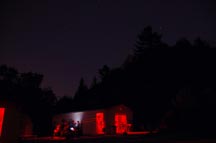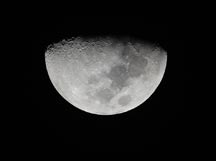

Becky's Gallery
|
Comet Hergenrother |
NGC 253- Sculptor Galaxy in Sculptor |
NGC 7380- Wizard Nebula in Cygnus Taken on Oct. 17 at 21:22 using an 8-inch Schmidt-Newtonian with the SBIG ST4K CCD camera. 6x5 min. exposures. CCDOPS: Dark subtracted with -20 C dark frame, then color processed with SRGB + Gamma. Stacked with Registax 5. Photoshop 7: Color balance, curves, sharpen, hue/saturation. Astro-Tools actions used- deep space noise reduction, enhance DSO and reduce stars, make stars smaller, color blotch reduction. |
NGC 6888- Crescent Nebula in Cygnus |
Spider Cradling Harvest Moon |
Jeff's Gallery
Courtney's Gallery
IC 348:
Taken on 11/10/12 at 10:12 pm at the Cabrillo Observatory using the 12” Telescope with the ST-2K Color Dual CCD Camera. 4X5 min exposures. CCDOPS: Dark subtracted with -30 C dark frame, then color processed using sRGB+ Gamma. Stacked in Registax using multipoint setting. Edited in photoshop using levels, curves, dust and scratches, and hue/saturation. Then using the astro tools for deep space noise reduction, make stars smaller, and reduce large blue halos.
|
NGC 1499- California Nebula:
Taken on 11/14/12 at the Cabrillo Observatory, using the using the Mead 8” Telescope on the LXD 75 Mount with ST4K ccd camera. 2x5 min. exposures. CCDOPS: Dark subtracted with -30 C dark frame, then color processed using sRGB+ Gamma. Stacked in Registax using multipoint setting. Edited in photoshop using levels, curves, hue/saturation, and healing brush. The using Astro tools for deep space noise reduction, make the stars smaller, and reduce the small blue halos.
|
NGC 7479:
Taken on 09/19/12 at 9:56 pm at the Cabrillo Observatory using the 12” Telescope with the ST-2K Color Dual CCD Camera. 3X5 min exposures. CCDOPS: Dark subtracted with -28 C dark frame, then color processed using sRGB+ Gamma. Stacked in Registax using multipoint setting. Cropped in photoshop and then edited in photoshop using levels and curves. Then using the astro tools for deep space noise reduction, less crunchy more fuzzy and color blotch reduction.
|
Dan's Gallery
23 Tauri - Merope |
M45 - Pleiades open star cluster |
NGC 6946 - Fireworks Galaxy.
|
Cabrillo Observatory |
NGC 7000 – North America Nebula |
Gene's Gallery
|
Globular Cluster M15 (NGC 7078) Eugene Salamin, 12" Meade LX200, ST2000XCM, 3x5 min Nov. 10, 2012 19:38-19:50 Cabrillo Observatory Dome CCDOPS: Version 5.54 build 15, Dark subtract -30C Flat field, Registax: Version 5.1, Stack 3 frames, Photoshop: Version 7.0 Levels (darken background), Healing brush (remove bad pixels),Space noise reduction, Local contrast enhancement, Make stars smaller x 2, Saturation +27, Crop and size for print and gallery |
Crab Nebula (M1), Supernova remnant.Eugene Salamin,12" Meade LX200, ST2000XCM, 5x5 min Nov. 11, 2012 00:19-00:47 UT, Cabrillo Observatory Dome CCDOPS: Version 5.54 build 15 Dark subtract -30C, Flat field, Color process sRGB+gamma, Registax: Version 6.1.0.8, Stack 5 frames Photoshop: Version 7.0, Levels (darken background), Healing brush (remove bad pixels), Space noise reduction x 3, Local contrast enhancement, Space noise reduction, Gaussian blur 0.5 pixels, Saturation +15, Crop and size for print and gallery |
Full Moon and Jupiter, Eugene Salamin, Nikon D40, 220mm focal length, Moon 1/15 s, Background 1 s, Nov. 28, 2012 - Cabrillo Observatory, Photoshop 7.0
Moon: Levels (suppress background to black), Healing brush (remove Jupiter), Make as Layer1 over Background layer, Move Moon over white disk on Background layer, Edit>transfor>scale: Make Moon bigger 102%, Background layer saturation +70 |
Ring Nebulae (M57), Planetary Nebula, Eugene Salamin & Becky Snow, 12" Meade LX200, ST2000XCM, 2x5 min, Sept. 19, 2012 21:21 to 21:29, Cabrillo Observatory Dome, CCDOPS: Version 5.54 build 13, Dark subtract -20C, Flat field, No color process, Registax: Version 5.1, Stack 2 frames, Photoshop: Version 7.0, Levels (increase contrast and darken background), Make stars smallerx3, Unsharp mask, 1.1 pixels, 40%, Saturation +20, Crop and size for print and gallery |
Triangulum Galaxy (M33, NGC598) Eugene Salamin, 8" Meade LDX75, ST4000XCM, 7x5 min , Oct. 17, 2012 22:35-23:13, Cabrillo Observatory, CCDOPS 5.54 build 15, Dark subtract -20C, Color process sRGB+gamma, Registax 6.1.0.8, Stack of 7 frames. Photoshop 7.0. Space noise reduction. Color blotch reduction, Healing brush (remove bad pixels), Color blotch reduction, Levels (darken background), Curves (increase contrast, reduce background), Color balance (green -5), (Local contrast enhancement+space noise reduction)x3, Curves (reduce green), Unsharp mask 65%, Healing brush (remove bad pixels), Crop and size for print and gallery |
Anne's Gallery
NGC 1499 California Nebula
|
M16 Eagle Nebula
|
NGC281 Pacman Nebula
|
Rachel's Gallery
 |
 |
Scott's Gallery
Instructor Notes:
The rainbow moon and Jupiter opportunity came on a cloudy night when we were simply going down to the observatory to get some things before heading back up to the lab to computer-work on our images. I had the Nikon, and quickly set it up on the tripod and tried setting it to get interesting compositions. I thought it would be of interest to show an instructor's version of the same shot. I took one of the original photos, added texture by using Astronomy Tools Actions: "enhance local contrast" 3x, then got a velvety texture from the result by "noise reduction" x2. Then used curves twice to raise the brightness and bring out the tree silhouette, unsharp mask to make the tree crisp, cropped out the uninteresting pine tree and focused in on the red halo, used photoshop saturation to bring up the color and show off the blue moon and red halo, then sized for this frame. Finally, I raised the scale by 9x to allow me to do micro-surgery on Jupiter at the top, fixing the black moat which resulted from using 'unsharp mask' by clone stamping the bright pixels to fill in the moat. This also brought up Jupiter's brightness.
When I get a moment, I'll try my hand at the lower exposure version which has lunar features. |